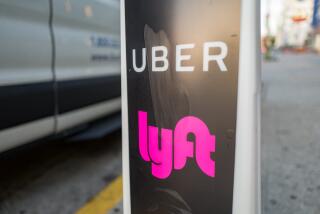Mercedes-Benz opens teen driving academy in L.A.
Anyone who’s driven on the 405 Freeway during rush hour understands: “L.A. is the driving capital of the U.S.,” said Carolyn Duchene, director of a new Mercedes-Benz Driving Academy for teens that is holding its first class in L.A. Saturday. The school is the second to be opened by the German car maker, which will be displaying an Academy vehicle and recruiting students during this week’s L.A. Auto Show.
“We chose L.A. because kids are being forced onto the roads regardless of whether they want to drive or not,” Duchene said.
Like the Driving Academy Mercedes opened in 2009 in a London suburb, the Mercedes-Benz Driving Academy in L.A. is geared toward teens. Car crashes are the No. 1 killer of teenagers in the U.S., according to the National Highway Transportation Safety Administration. About 20,000 teenagers die in car crashes each year, according to the American Automobile Assn.
Few California schools offer driver education, due to insufficient funds. The approach to driver education has changed little in the last 60 years, despite radical changes in roadways, technology and automotive design, Duchene said.
The California Department of Motor Vehicles requires 30 hours of classroom training and six hours of behind-the-wheel experience with an instructor as part of the state’s licensing process for individuals younger than 18. But Duchene said the 36 hours of state-required driver education “in and of itself has not been proven to improve road safety.”
The Mercedes curriculum, which received California state approval last week, includes 15 hours of online instruction, 10 hours of classroom study, a three-hour safety workshop, a two-hour distracted driving exercise and 16 hours of coached driving instruction.
Ninety percent of car crashes are the result of driver error, according to the U.S. Department of Transportation. Seventy-five percent of fatal teen crashes have nothing to do with drugs or alcohol, according to the U.S. Centers for Disease Control.
“They’re the result of inexperience, poor decision making and distractions,” Duchene said.
Students who pay $1,390 to attend the Mercedes Academy will be enrolled for six months. They start with an online self-study session explaining basic road rules and road types. Each student is then paired with a driving coach at which time the online training is reinforced with behind-the-wheel instruction.
Over four weeks, students alternate between online study at home followed by two-hour, behind-the-wheel sessions with an instructor, after which students take a test for their learners permit through the Department of Motor Vehicles. After receiving their permits, their parents are folded in to the next behind-the-wheel lesson, to help them serve as better guides for their kids during the 50 hours of supervised driving required under California’s graduated driver licensing framework.
The program is designed to develop decision-making skills by engaging students with coaching and questions rather than issuing rote instruction. “An instructor would say, ‘Go to the stop sign and make a right.’ A coach says, ‘You’re coming up on a stop sign. What do you have to do and why?’” Duchene offered by way of example.
Over the subsequent five months of the program, students receive another 10 hours of classroom training and six hours with a Mercedes driving coach. During the program’s safety workshop, students are taught how to inspect a car for defects. During its distracted driver exercise, students drive through a specially designed course with and without common in-car distractions such as loud music, cellphones and passengers.
The school uses a mix of Mercedes-Benz C class sedans and larger ML hybrids because “so many kids that get licenses learn in small cars and their first car is an SUV,” Duchene said. “We wanted students to learn on a vehicle similar to what they’ll be driving once they’re out on the road.”
According to the U.S. Centers for Disease Control, car crashes are most likely to occur in a youth’s first year of driving; teens are four times more likely to get into a crash than an adult.






